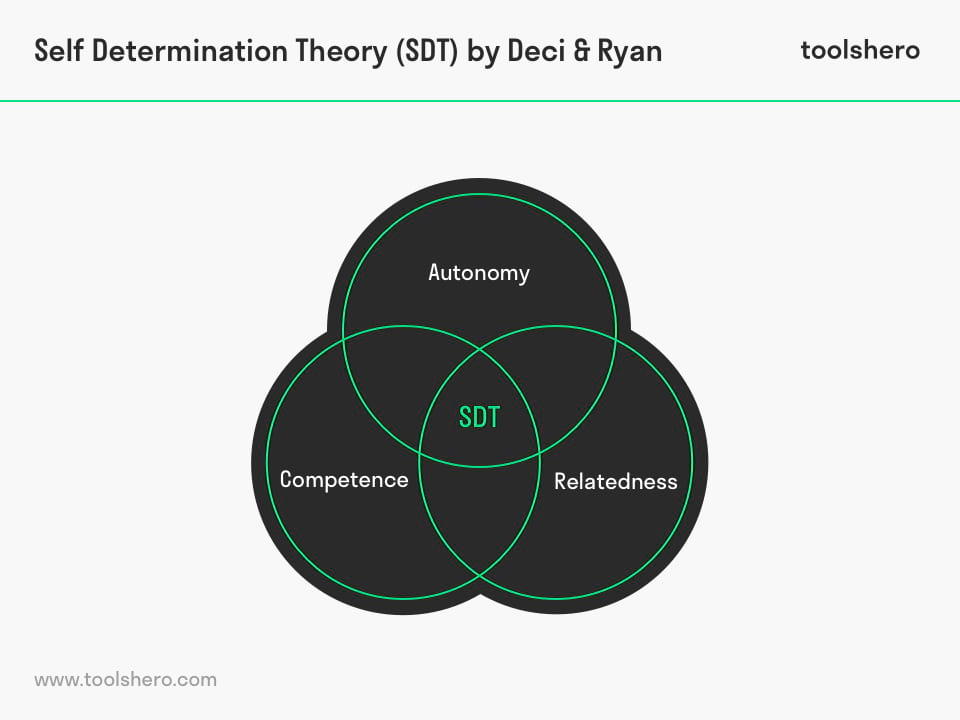Self Determination Theory by Deci and Ryan explained

Self Determination Theory: this article explains the Deci and Ryan Self Determination Theory or SDT, developed by Edward L. Deci and Richard Ryan in a practical way. Next to what it is, this article also highlights the difference between extrinsic and intrinsic factors, the model, the importance of social surroundings and sub-theories. Enjoy reading!
What is Self Determination Theory?
A lot of theories have developed about motivation over the years. One of those is the Self Determination Theory (SDT), from the eighties of the last century, by the American professor of psychology Edward L. Deci and the American professor in clinical psychology Richard Ryan.
Deci and Ryan Self Determination Theory focusses on the human motivation and personality, which relate to, among other things, the innate psychological human needs. It researches the reasons behind the choices people make from themselves, without being influenced by external factors.
It is about individual behaviour with which people motivate themselves and from which they handle.
Extrinsic and intrinsic
The external factors that stimulate, motivate and move a person, are called extrinsic motivators. Within organisations this means that employees are extrinsically motivated by, for example, external rewards, annual numbers, evaluations and references.
The opinion their colleagues have of them, also belongs to this category. On the other hand, people are also motivated and stimulated from within.
It is their personal interest, curiosity, or drive to learn something new, that belongs to this intrinsic motivation. People who are motivated intrinsically, tend to stay motivated in the long term, as opposed to people who are motivated extrinsically.
This develops passion, creativity, and determination. The interconnection between the extrinsic and the intrinsic motifs form the basis of the Self Determination Theory.
Self Determination Theory by Extrinsic and intrinsic is about psychological needs
Man is an active organism that improves, seeks personal growth, and lifts itself to a higher level. This development with regards to thinking is a natural proces, but from Self Determination Theory stems the belief that it isn’t an entirely automated one.
It demands ongoing social nutrients and support. The social context can support or block this psychological growth. The tension field between the man and his social context determines his behaviour, experiences and developments.
SDT believes that the most desirable and high-value forms of motivation and involvement are perseverance, improved performance, and creativity. To support this, autonomy, competence, and relatedness are essential. Failure to support one of these three psychological needs within the social context will have a detrimental effect on one’s well-being.

Figure 1 – Self Determination Theory model
The importance of social surroundings within the Self Determination Theory
The Self Determination Theory emphasizes the natural growth of people towards positive motivation. People must be nourished by the social environment, which leads to improved happiness and well-being. If this doesn’t happen, and the basic needs are not met, there will be negative consequences.
The need for autonomy, competence, and relatedness are three universal and congenital psychological needs, according do Deci and Ryan. When satisfied they lead to optimal motivation. SDT assumes that man exhibits positive qualities, makes an effort and allows freedom of choice.
Within the Self Determination Theory this is known as the inherent growth tendencies. In addition, man has the innate psychological need for self-motivation. When the three elementary psychological needs are met, this will increase health and well-being.
These needs can be applied universally, but can manifest differently based on time, culture, or experience:
Autonomy
This is the urge to see connections between one’s own actions and those of others in the environment. Edward L. Deci and Richard Ryan discovered that extrinsic rewards for intrinsically motivated behaviour undermined intrinsic motivation. Resulting in a decrease of autonomy. It is better to reward intrinsic behaviour intrinsically, as it grants an individual the idea of having more control over his/her life.
Competence
This is about the urge to control the outcome, as well as the control of your own experiences. Edward L. Deci and Richard Ryan discovered that giving unexpected positive feedback increases people’s intrinsic motivation. Positive feedback therefore leads to a high competence level; it increases the intrinsic motivation but decreases the extrinsic motivation.
Relatedness
This is about the urge for connection with the environment and other individuals. It is also known as ‘psychological connection’. Man is a social animal and has the need to be, and communicate with, other humans.
Online course: Positive Psychology Coaching
Self Determination Theory and sub-theories
Formally, the Self Determination Theory consists of 6 sub-theories that have been developed to explain motivational phenomena.
Firstly, this is the Cognitive Evaluation Theory, which relates to intrinsic motivation. Second is Organismic Integration Theory, which dives into the extrinsic motivation and the behaviour paired with it.
The third theory is that of Causality Orientations, which describes individual differences in the way people orient themselves to the environment and regulate behaviour in different ways. For example, individuals act out of interest and/or from what happens in their environment.
The fourth theory is that of the Basic Psychological Needs, which shows that psychological well-being and optimal functioning are based on autonomy, competence, and relatedness. In essence, this forms the basis for the Self Determination Theory.
The fifth theory is the Goal Contents Theory, in which the difference between intrinsic and extrinsic goals, and their impact on the motivation and the well-being of man, are described. Extrinsic goals, such as financial success and fame, are diametrically opposed to intrinsic goals. In the latter case, think of appreciation, interpersonal relationships, and self-realization.
The final is the Relations Motivation Theory, which focusses on all possible human relations and interactions that are essential for behaviour, adaptation, and well-being.
It’s Your Turn
What do you think? Have you ever heard of the Deci and Ryan Self Determination Theory? Do you recognize the practical explanation or do you have more suggestions? What are your success factors for personal happiness and how do you get motivated?
Share your experience and knowledge in the comments box below.
More information
- Deci, E. L. & Ryan, R. M. (1985). Intrinsic motivation and self-determination in human behavior. New York: Plenum.
- Deci, E. L. & Ryan, R. M.(2006). The Handbook of Self-Determination Research. University of Rochester Press.
- Gagné, M., & Deci, E. L. (2005). Self‐determination theory and work motivation. Journal of Organizational behavior, 26(4), 331-362.
- Ryan, R. M., & Deci, E. L. (2017). Self-determination theory: Basic psychological needs in motivation, development, and wellness. New York: Guilford Publishing.
- Worfolk, C. (2024). Positive Psychology Coaching. Retrieved 02/15/2024 from Udemy.
How to cite this article:
Mulder, P. (2018). Self Determination Theory (SDT). Retrieved [insert date] from Toolshero: https://www.toolshero.com/psychology/self-determination-theory-sdt/
Original publication date: 03/14/2018 | Last update: 02/15/2024
Add a link to this page on your website:
<a href=”https://www.toolshero.com/psychology/self-determination-theory-sdt/”>Toolshero: Self Determination Theory (SDT)</a>












